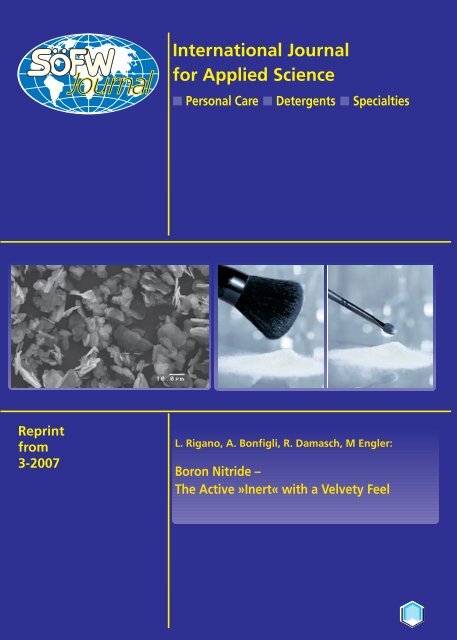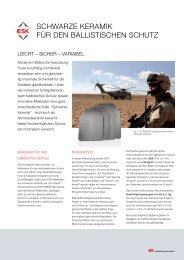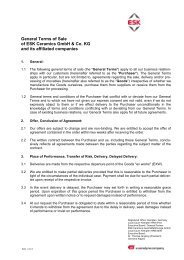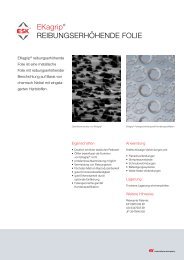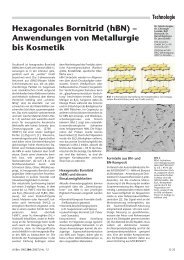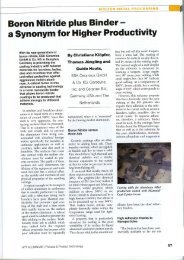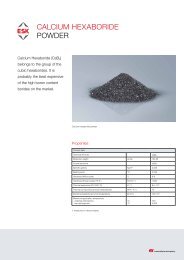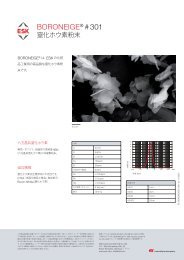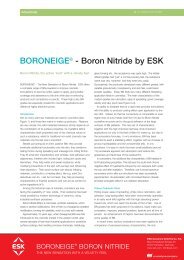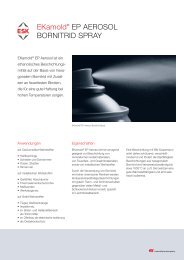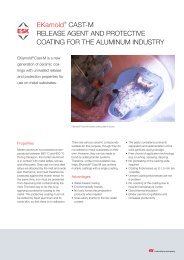Boron Nitride â The Active »Inert« with a Velvety Feel Reprint from ...
Boron Nitride â The Active »Inert« with a Velvety Feel Reprint from ...
Boron Nitride â The Active »Inert« with a Velvety Feel Reprint from ...
Create successful ePaper yourself
Turn your PDF publications into a flip-book with our unique Google optimized e-Paper software.
<strong>Reprint</strong><br />
<strong>from</strong><br />
3-2007<br />
International Journal<br />
for Applied Science<br />
■ Personal Care ■ Detergents ■ Specialties<br />
L. Rigano, A. Bonfigli, R. Damasch, M Engler:<br />
<strong>Boron</strong> <strong>Nitride</strong> –<br />
<strong>The</strong> <strong>Active</strong> »Inert« <strong>with</strong> a <strong>Velvety</strong> <strong>Feel</strong>
COSMETICS<br />
BORON NITRIDE<br />
L. Rigano* , A. Bonfigli* , R. Damasch **, M. Engler **<br />
<strong>Boron</strong> <strong>Nitride</strong> –<br />
<strong>The</strong> <strong>Active</strong> »Inert« <strong>with</strong> a <strong>Velvety</strong> <strong>Feel</strong><br />
Keywords: <strong>Boron</strong> <strong>Nitride</strong> Powder, colour cosmetic formulations, active filler, skin care<br />
N<br />
ot so many solid raw materials<br />
are used in cosmetics<br />
and those few mainly<br />
in make-up products:<br />
•Talc<br />
•Pigments<br />
•Sericite<br />
•Kaolin<br />
•Mica<br />
•Precipitated Calcium Carbonate<br />
•Light Magnesium Carbonate<br />
•Pyrogenic silica<br />
•Di-calcium and Mono-calcium<br />
phosphate<br />
•Calcium stearate<br />
•Alumina<br />
•Pearls (Titanium dioxide and<br />
other pigments on Mica<br />
•Bismute oxychloride<br />
•Nylon<br />
•Polymethylmethacrylate<br />
•Zinc oxide<br />
•Calamine<br />
Reasons are very simple: the solid<br />
materials behavior strictly depends<br />
on the combination of its<br />
surface properties, its crystalline<br />
lattice characteristics (bulk properties)<br />
and of the chemical na-<br />
Introduction<br />
ture of such a substance, while<br />
for traditional non-solid cosmetic<br />
raw materials only the last one is<br />
important.<br />
Solids often pass a milling treatment<br />
as confinement, a sometimes<br />
sophisticated operation,<br />
which has typically a hard to<br />
control outcome, as the dimensions<br />
of particles of these micromilled<br />
powders scatter statistically<br />
around an targeted, average<br />
value. <strong>The</strong>ir surface activity<br />
is consequently variable. Moreover,<br />
it is influenced by its zeta<br />
potential, by absorbed gas or humidity.<br />
Finally the surface of such<br />
solid particles can show a selective<br />
absorption for the wetting<br />
liquids. This can become a problem<br />
in formulation development,<br />
when cosmetic blends of several<br />
ingredients are used in combination.<br />
Nevertheless, solids are intriguing<br />
materials. Beside just acting<br />
as an inert, passive filler, they<br />
provide eventually additional<br />
functionality. Onto the skin, they<br />
transform sliding friction during<br />
spreading and massage into<br />
rolling friction. <strong>The</strong>y fill small<br />
skin imperfections and wrinkles,<br />
help adhesion and slipperiness,<br />
interfere <strong>with</strong> incident light, hiding<br />
skin spots and blemishes.<br />
<strong>The</strong>y help water and sweat resistance,<br />
while modifying interactions<br />
of the skin <strong>with</strong> sun rays<br />
and influencing heat dispersion.<br />
<strong>The</strong>ir active surface can absorb<br />
irritating materials, contribute to<br />
a healing effect, like e.g. solid<br />
Zinc derivatives can do. Last but<br />
not least, they help processing<br />
characteristics of finished products<br />
and can act as carriers for<br />
active ingredients (1).<br />
Among the historical uses of<br />
minerals, cosmetics are now facing<br />
the availability of ‘new’<br />
solids. <strong>The</strong>ir existence has been<br />
made possible by modern technology<br />
of ceramics, using industrial<br />
synthesis processes, reaching<br />
temperatures as high as<br />
2000 °C and sometimes hundreds<br />
of atmospheres of pressure<br />
for creating new solids. <strong>Boron</strong> <strong>Nitride</strong><br />
is one of these synthetic<br />
solid materials born <strong>from</strong> extreme<br />
conditions.<br />
2 SÖFW-Journal | 133 | 3-2007
� <strong>Boron</strong> <strong>Nitride</strong><br />
<strong>Boron</strong> <strong>Nitride</strong> (BN) is a manmade, synthetic<br />
substance, which exists in several<br />
modifications. In its cubic form (cBN),<br />
<strong>Boron</strong> <strong>Nitride</strong> is the second hardest material<br />
after diamond. It requires 5000 atmospheres<br />
to be produced, its melting<br />
point is 2967 °C (2) and its micro-hardness<br />
is estimated around 4000 kg/mm 2 .<br />
It was first prepared in 1842, but its<br />
real industrial production started in the<br />
1950s.<br />
BN exists also in a hexagonal crystalline<br />
modification, forming thin platelets,<br />
which is then in contrary a very soft material.<br />
Indeed, there are many similarities<br />
between the chemistry of Carbon and<br />
<strong>Boron</strong> <strong>Nitride</strong>: they are isoelectronic. <strong>The</strong><br />
cubic forms of both substances are very<br />
hard, as in the case of diamond, while the<br />
hexagonal forms (graphite and hexagonal<br />
BN) are soft and lubricant. <strong>Boron</strong> <strong>Nitride</strong><br />
can give rise to fullerenes-analogue<br />
compounds.<br />
In the graphitic form (hBN), the crystalline<br />
structure is hexagonal, <strong>with</strong> Nitrogen<br />
and <strong>Boron</strong> sp2 bonded, in alternating<br />
sequence forming stacks of 2-dimensional<br />
layers. In literature, it is often<br />
called graphitic Born <strong>Nitride</strong> or »white<br />
graphite«. hBN has a »white« colour, does<br />
not adsorb visible light (whiteness as<br />
measured by colorimetry parallels that of<br />
Titanium dioxide), contrary to graphite, as<br />
in BN electrons are not delocalised as in<br />
graphite, but permanently resident around<br />
the more electronegative Nitrogen atom,<br />
outside the conductivity band. hBN is<br />
considered as one of the most promising<br />
fine ceramics due to its high electrical<br />
resistivity, excellent thermal conductivity<br />
(heat transmission is mediated by<br />
phonons and not by electrons), chemical<br />
resistance and extremely low dielectric<br />
constant. Its different, modern synthesis<br />
can start <strong>from</strong> organo-boron compounds,<br />
boranes <strong>with</strong> nitrogen, or nitrogen-containing<br />
compounds like urea or melamine<br />
<strong>with</strong> boric acid in Nitrogen atmosphere,<br />
even <strong>Boron</strong> trioxide reacting <strong>with</strong> ammonia.<br />
Very fine powders can be produced<br />
by reacting elemental <strong>Boron</strong> <strong>with</strong><br />
Nitrogen in a plasma at 5000 °C (3).<br />
Synthesis conditions, temperature, reagents,<br />
inert gas, concentration can strongly<br />
influence the outcome (yield, purity,<br />
Fig. 1 Typical SEM picture of a <strong>Boron</strong> <strong>Nitride</strong> powder<br />
crystallinity) of the high temperature reaction<br />
of the formation of hexagonal<br />
<strong>Boron</strong> <strong>Nitride</strong>. Typical, industrial synthesis<br />
temperatures range <strong>from</strong> 900 °C to<br />
1600 °C, but even higher temperatures<br />
are used for highest quality grades. Resistant<br />
to oxidation up to 850°C to<br />
1000 °C, in its purest grades, BN purity is<br />
higher than 99.5%, the other impurities<br />
being mainly B2O3 (~ 0.03%) and Oxygen<br />
(~ 0.3%), some Carbon (0.1%) or<br />
metallic impurities (0.01%) like Na, Ca,<br />
Si, Fe (4). A standard quality can show a<br />
Fig. 2 <strong>Boron</strong> <strong>Nitride</strong> in cosmetic applications<br />
COSMETICS<br />
BORON NITRIDE<br />
mean primary particle size around 3<br />
microns, and a corresponding average<br />
surface area of approximately 15 m 2 /g<br />
(Fig. 1).<br />
� Cosmetic Applications<br />
15 years ago, when (hexagonal) BN<br />
was first introduced to the cosmetic<br />
market in the western world, after several<br />
decades of technical industrial applications<br />
in protective surface coatings,<br />
SÖFW-Journal | 133 | 3-2007 3
COSMETICS<br />
BORON NITRIDE<br />
like handling corrosive chemicals, metallurgy,<br />
glass forming etc., the acceptance<br />
was quite high. <strong>The</strong> initially offered grades<br />
had »just« a normal powdery feel, the<br />
substance name was very ‘synthetic’<br />
and they were very costly. Successively,<br />
the producers developed many different<br />
grades, <strong>with</strong> variable granulometry, transparency<br />
and skin feel, customized powder<br />
qualities. Today, <strong>Boron</strong> <strong>Nitride</strong> finds<br />
very many different interesting application<br />
fields in cosmetics. <strong>The</strong> main characteristics<br />
of the modern grades are: lubrication,<br />
ease of spreading, good coverage,<br />
velvety and silky touch (Fig. 2) .<br />
Its ability to dissipate heat at a rapid rate<br />
provides formulations <strong>with</strong> the ability to<br />
produce cooling effect upon application<br />
to the skin (5). Indeed, its thermal conductivity<br />
is comparable or even higher<br />
than of pure metals (400 W/mK) due to<br />
<strong>Boron</strong> <strong>Nitride</strong> crystalline structure and to<br />
the good adhesion of the large surfaces<br />
of BN platelets. Just to make an example<br />
mineral rocks are <strong>from</strong> 1000 to 10 times<br />
less conductive. This nice set of characteristics,<br />
together <strong>with</strong> the high chemical<br />
inertness, finds important applications<br />
not only in the field of fillers for<br />
make-up, but also in the sun-screens<br />
formulae. In w/o emulsions, BN has been<br />
reported to exert a stabilizing effect,<br />
together <strong>with</strong> an increase of product<br />
spreadability and skin smoothness (6). In<br />
o/w emulsions, it is easy to verify that<br />
even small additions (around 1%) accelerate<br />
apparent skin absorption and reduce<br />
the greasiness and tackiness of the<br />
residual film.<br />
In sunscreens, the additional key characteristic<br />
of BN resides in its IR-absorbing<br />
properties. This reduces the acute and<br />
chronic negative effect of hyperaemia<br />
induced by sun exposure both under the<br />
sun and after irradiation. <strong>The</strong>refore, use<br />
in broad-spectrum sunscreens and in after-sun<br />
emulsions has been successfully<br />
experimented. Its association <strong>with</strong> micronized<br />
titanium dioxide provides synergistic<br />
effect in sun radiation absorption.<br />
� Colour Cosmetic Uses<br />
Hiding power, ease of spreading, white<br />
colour, lubrication, skin adhesion, long-<br />
lasting effect have been instrumentally<br />
quantified in an early work (7) together<br />
<strong>with</strong> the high absorbing power toward<br />
oils, which can reach the double of that<br />
of talc. Use of BN grades has been proposed<br />
in foundations, liquid make ups,<br />
concealers, mascara, pressed powders,<br />
lipsticks and all kind of pencils. An enhancement<br />
of haptics has been demonstrated<br />
for some grades of BN.<br />
In recent times, sensory evaluations have<br />
been applied to the comparison of perceived<br />
sensory characteristics, the only<br />
measurements that allow a direct communication<br />
between the formulator and<br />
the consumer. No objectively sound sensory<br />
evaluation has been ever applied to<br />
the evaluation of BN properties. In a series<br />
of experiments (8) the ‘<strong>Boron</strong> <strong>Nitride</strong><br />
powder’ – BORONEIGE ® - was evaluated<br />
in comparison <strong>with</strong> five different fillers,<br />
in order to compare their performances<br />
related to the following sensory features:<br />
• spreadability: ease of moving product<br />
over the skin;<br />
• skin coverage degree: product’s ability<br />
to cover the skin;<br />
• skin coverage homogeneity: homogeneity<br />
level in the skin coverage;<br />
Fig. 3 Raw materials applied on forearms<br />
• skin softness: intensity of velvety skinfeel<br />
perceived by gently touching the<br />
treated forearm area <strong>with</strong> the fingers.<br />
16 trained panellists evaluated the samples<br />
according to a standard protocol<br />
and ranked them <strong>with</strong> regard to the intensity<br />
degree of each selected parameters.<br />
This test (9-12) was repeated twice<br />
in order to insure accuracy and reproducibility.<br />
<strong>The</strong>n, rank sums are calculated<br />
and analyzed by means of statistical<br />
analysis. <strong>The</strong> assessment was performed<br />
on the forearms’ skin according to a balanced<br />
and randomized order of presentation<br />
(Fig. 3) .<br />
Firstly, the technician delivered a standard<br />
quantity of each sample in a marked<br />
site of the fore-arms, than the panellists<br />
spread the powder by a constant and<br />
elliptic movement of their index finger.<br />
Finally they evaluated individually the<br />
listed four sensory parameters. For each<br />
sample and each parameter under test,<br />
the Rank position given by each panellist<br />
and the Rank Sum obtained by<br />
adding all individual rank positions of<br />
each panellist are calculated. Successively,<br />
the Rank Sums are analyzed by<br />
means of Friedman statistical test and<br />
finally the critical value of LSD (Least<br />
Significant Difference) is calculated, to<br />
4 SÖFW-Journal | 133 | 3-2007
COSMETICS<br />
BORON NITRIDE<br />
Samples Polymethyl Mica Talc extra Bismuth Nylon-12 BORONEIGE®<br />
Methacrylate 40 micron Oxychloride (<strong>Boron</strong> <strong>Nitride</strong>)<br />
dec.<br />
Spreadability 35.0 47.5 53.5 74.5 56.5 68.5<br />
Skin coverage degree 20.5 60.5 45.0 81.0 51.0 77.0<br />
Skin coverage homogeneity 21.5 60.0 49.0 84.5 51.0 70.0<br />
Skin softness 35.0 59.0 48.0 75.5 48.5 68.5<br />
Table 1 Rank sum for each tested sample<br />
identify the pairs of rank sums that differ<br />
<strong>from</strong> each other. LSD value is the<br />
smallest difference between rank sums<br />
of any pair of samples that is necessary<br />
in order to state that products are significantly<br />
different, in relation to the selected<br />
attribute.<br />
In this study, the LSD value is equal to<br />
20.7. Consequently the pairs of samples,<br />
whose »rank sum« differs by a value<br />
greater than 20.7, can be considered significantly<br />
different in the evaluated sensory<br />
features. In Table 1 the »rank sum«<br />
obtained for each tested sample: the<br />
higher the value, the better the performance.<br />
<strong>The</strong> Friedman test, applied to the rank<br />
sum obtained, evidences that there are<br />
significant differences between products:<br />
p < 0.05. On the basis of LSD value,<br />
a multiple comparison test between the<br />
rank sums of samples is performed. <strong>The</strong><br />
results are reported in Tables 2-5, where<br />
( s ) means that the two products are significantly<br />
different in the investigated<br />
attribute (p < 0.05).<br />
Spreadability Polymethyl Mica Talc extra Bismuth Nylon-12 BORONEIGE®<br />
(LSD) Methacrylate 40 micron Oxychloride (<strong>Boron</strong> <strong>Nitride</strong>)<br />
dec.<br />
Polymethyl Methacrylate - N.S N.S s s s<br />
Mica N. S - N.S s N.S s<br />
Talc extra 40 micron dec. N .S N.S - s N.S N.S<br />
Bismuth Oxychloride s s s - N.S N.S<br />
Nylon-12 s N.S N.S N.S - N.S<br />
<strong>Boron</strong> <strong>Nitride</strong> Powder s s N.S N.S N.S -<br />
Table 2 Rank sum of samples<br />
Skin coverage Polymethyl Mica Talc extra Bismuth Nylon-12 BORONEIGE®<br />
Degr ee Methacrylate 40 micron Oxychloride (<strong>Boron</strong> <strong>Nitride</strong>)<br />
(LSD) dec.<br />
Polymethyl Methacrylate - s s s s s<br />
Mica s - N.S N.S N.S N.S<br />
Talc extra 40 micron dec. s N.S - s N.S s<br />
Bismuth Oxychloride s N.S s - s N.S<br />
Nylon-12 s N.S N.S s - s<br />
<strong>Boron</strong> <strong>Nitride</strong> Powder s N.S s N.S s -<br />
Table 3 Rank sum of samples<br />
SÖFW-Journal | 133 | 3-2007 5
COSMETICS<br />
BORON NITRIDE<br />
Skin coverage Polymethyl Mica Talc extra Bismuth Nylon-12 BORONEIGE®<br />
Homogeneity Methacrylate 40 micron Oxychloride (<strong>Boron</strong> <strong>Nitride</strong>)<br />
(LSD) dec.<br />
Polymethyl Methacrylate - s s s s s<br />
Mica s - N.S s N.S N.S<br />
Talc extra 40 micron dec. s N.S - s N.S s<br />
Bismuth Oxychloride s s s - s N.S<br />
Nylon-12 s N.S N.S s - N.S<br />
<strong>Boron</strong> <strong>Nitride</strong> Powder s N.S s N.S N.S -<br />
Table 4 Rank sum of samples<br />
Skin softness Polymethyl Mica Talc extra Bismuth Nylon-12 BORONEIGE®<br />
(LSD) Methacrylate 40 micron Oxychloride (<strong>Boron</strong> <strong>Nitride</strong>)<br />
dec.<br />
Polymethyl Methacrylate - s N.S s N.S s<br />
Mica s - N.S N.S N.S N.S<br />
Talc extra 40 micron dec. N.S N.S - s N.S N.S<br />
Bismuth Oxychloride s N.S s - s N.S<br />
Nylon-12 N.S N.S N.S s - N.S<br />
<strong>Boron</strong> <strong>Nitride</strong> Powder s N.S N.S N.S N.S -<br />
Table 5 Rank sum of samples<br />
� Conclusions<br />
Analyzing the 4 sensory features of these<br />
typical cosmetic fillers and <strong>Boron</strong> <strong>Nitride</strong><br />
resulted in an interesting ranking.<br />
• Spreadability, <strong>from</strong> the easiest to<br />
spread to the least easy to spread:<br />
<strong>Boron</strong> <strong>Nitride</strong> Powder = Bismuth Oxychloride<br />
> Nylon-12 > Talc Extra 40<br />
Micron Dec > Mica > Polymethyl<br />
Methacrylate.<br />
• Skin coverage degree, in order of the<br />
performance level <strong>from</strong> high to low:<br />
<strong>Boron</strong> <strong>Nitride</strong> Powder = Bismuth Oxychloride<br />
> Mica > Nylon-12 > Talc<br />
Extra 40 Micron Dec > Polymethyl<br />
Methacrylate.<br />
• Skin coverage homogeneity, in order<br />
of the performance level <strong>from</strong> high to<br />
low:<br />
<strong>Boron</strong> <strong>Nitride</strong> Powder = Bismuth Oxychloride<br />
> Mica > Nylon-12 > Talc<br />
Extra 40 Micron Dec > Polymethyl<br />
Methacrylate.<br />
• Skin softness, in order of the performance<br />
level <strong>from</strong> high to low:<br />
<strong>Boron</strong> <strong>Nitride</strong> Powder = Bismuth Oxychloride<br />
> Mica > Nylon-12 > Talc<br />
Extra 40 Micron Dec > Polymethyl<br />
Methacrylate.<br />
In general, BORONEIGE® <strong>Boron</strong> <strong>Nitride</strong><br />
Powder and Bismuth Oxychloride gave<br />
the best performances in all evaluated<br />
sensory characteristics. <strong>The</strong>y were perceived<br />
similar <strong>with</strong>out any statistically<br />
significant difference.<br />
Following conclusion can be drawn <strong>with</strong><br />
regard to these test results:<br />
BORONEIGE® <strong>Boron</strong> <strong>Nitride</strong> is a high potential<br />
active filler, as it not only contributes<br />
to formulations in terms of lu-<br />
brication, high oil absorbing power, stabilization<br />
of emulsions, skin adhesion,<br />
hiding power and coverage degree, etc.,<br />
but also provides additionally very homogeneous<br />
and easy spreadability and<br />
giving the skin a soft and silky feeling.<br />
As a »synthetic« solid <strong>Boron</strong> <strong>Nitride</strong>,<br />
BORONEIGE® is the perfect additive <strong>with</strong><br />
the »velvety touch« to all colour cosmetic<br />
formulations. Availability in large volumes<br />
at attractive prices enables formulators<br />
to use BORONEIGE® <strong>Boron</strong> <strong>Nitride</strong><br />
as a raw material for the latest state of<br />
the art formulations.<br />
BORONEIGE® is a registered and protected<br />
trademark by ESK Ceramics GmbH &<br />
Co. KG, Kempten, Germany.<br />
Literature<br />
(1) A nselmann R, Hillgärtner U (1999) Cosmetics<br />
and Toiletries Manufacture Worldwide; 203-7<br />
6 SÖFW-Journal | 133 | 3-2007
(2) Inagawa K, Watanabe K, Ohsone H, Saitoh K,<br />
Itoh A. (1987) Preparation of cubic boron nitride<br />
film by activated reactive evaporation<br />
<strong>with</strong> a gas activation nozzle. Journal of Vacuum<br />
Science & Technology A: Vacuum, Surfaces<br />
and Films; 5 (4) 2696-700<br />
(3) Vilcarromero J, Carreño MNP, Perey-ra I, Cruz<br />
NC, Rangel EC. (2002) Preparation and Characterization<br />
of Nanocrystalline h-BN Films<br />
Prepared by PECVD Method. Braz. J. Phys. vol.<br />
32 (6) no.2a<br />
(4) Stephan R. <strong>Boron</strong> <strong>Nitride</strong>. (1994) American<br />
Ceramic Society Bulletin 736, 89-90<br />
(5) Esposito M (2002) <strong>The</strong> Cooling Effect of<br />
<strong>Boron</strong> <strong>Nitride</strong> in Cosmetic Formulations. Cosmetics<br />
and Toiletries Manufacture Worldwide;<br />
36-39<br />
(6) Introini C (1997) <strong>Boron</strong> <strong>Nitride</strong>, a new ingredient<br />
in body care and sunscreens (in Italian).<br />
Cosmetics & Toiletris It. Ed. (2) 71-6<br />
(7) Introini C (1997) <strong>Boron</strong> <strong>Nitride</strong>, a new special<br />
ingredient in make-up (in Italian). COSDNG<br />
(114) 194-6<br />
(8) ISPE study 47/06/06 (2006) internal report<br />
(9) Mac Leod P, Sauvageot F (1986) Bases neurophysiologiques<br />
de l'evaluation sensorielle de<br />
produits alimentaires. Les cahiers de l'Ens. Bana,<br />
N 5 – (2)<br />
(10) SSHA et ISHA (1990) Evaluation sensorielle.<br />
Manuel metodologique - Collection sciences<br />
et techniques agro-alimentaires - Technique<br />
et Do- cumentation - Lavoisier<br />
(11) Meilgaard, Civille, Carr (1991) Sensory evaluation<br />
tecniques - 2 nd Edition CRC PRESS, INC<br />
(12) ASTM manual on consumer and sensory evaluation.<br />
(1986) ASTM Special Technical Publication<br />
682 - American Society for Testing and<br />
Materials<br />
COSMETICS<br />
BORON NITRIDE<br />
Authors’ addresses:<br />
* Dr. Luigi Rigano<br />
Rigano Laboratories<br />
Via Bruschetti, 1<br />
20125 Milan<br />
Italy<br />
Email: rigano@thecosmetologist.com<br />
* Dr. Adriana Bonfigli<br />
ISPE Laboratories<br />
Via Bruschetti, 1<br />
20125 Milan<br />
Italy<br />
** Ralf Damasch<br />
Dr. Martin Engler<br />
ESK Ceramics GmbH & Co. KG<br />
Max-Schaidhauf-Strasse 25<br />
87437 Kempten<br />
Germany<br />
Email: info@esk.com<br />
BORONEIGE ® BORON NITRIDE<br />
THE ACTIVE INERT WITH A VELVETY FEEL<br />
ESK Ceramics GmbH & Co. KG<br />
Max-Schaidhauf-Strasse 25<br />
87437 Kempten, Germany<br />
www.esk.com, info@esk.com<br />
SÖFW-Journal | 133 | 3-2007 7<br />
�
ESK Ceramics GmbH &Co. KG<br />
Max-Schaidhauf-Straße 25<br />
87437 Kempten, Germany<br />
Tel.: +49 831 5618-0<br />
Fax: +49 831 5618-345<br />
www.esk.com, info@esk.com<br />
BORONEIGE® is aregistered trademarkofESK Ceramics GmbH &Co. KG


